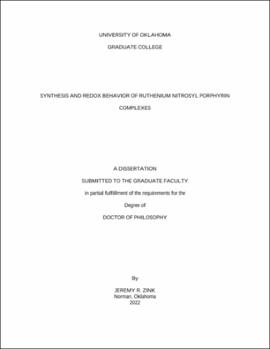| dc.description.abstract | This dissertation details the synthesis, characterization, and redox behavior of various six-coordinate ruthenium nitrosyl porphyrin complexes. The primary focus of this work is centered on factors that impact the redox behavior and the reactivity of these previously unreported compounds.
Chapter 1 introduces, in a broader sense, the interactions of nitric oxide with heme proteins and the utilization of synthesized metalloporphyrins as models. Specifically, this dissertation focuses on employing ruthenium as the metal center, and I place my work in context of related adducts from previous research by former group members and others.
Chapter 2 describes the preparation of aryloxide complexes (por)Ru(NO)(OArxH) (por = OEP and T(p-OMe)PP; x = 0, 1, 2) from the alcohol exchange reaction of the corresponding (por)Ru(NO)(OR) precursors with the appropriate phenol reagent containing an increasing number of internal hydrogen bonds. These nitrosyl aryloxide complexes were characterized by X-ray crystallography, and IR and 1H NMR spectroscopy. The IR spectra exhibit higher νNO frequencies in compounds possessing more internal hydrogen bonds, a result of diminished π-backdonation to the Ru-NO fragment. Similarly, crystal structures of the OEP and T(p-OMe)PP complexes display a trend of increasing Ru-O bond lengths with increasing intramolecular hydrogen bonds. This is also reflected in the redox behavior of these (por)Ru(NO)(OArxH) complexes, which have been examined by cyclic voltammetry and IR-spectroelectrochemistry, showing the first oxidation occurs at an increasingly positive potential with more intramolecular hydrogen bonds present. The subsequent chemical process for the 0- and 1-H compounds become more reversible at scan rates above 200 mV/s while the 2-H complexes displayed chemically irreversible oxidations. An aryloxide ligand-centered oxidation and dissociation was confirmed via chemical oxidation of (OEP)Ru(NO)(OAr2H) with AgPF6 and supported by DFT calculations for the frontier molecular orbitals of these (porphine)Ru(NO)(OArxH) complexes.
Chapter 3 details the synthesis and reactivity of several ruthenium nitroxyl (HNO) porphyrin complexes. The preparation of these (por)Ru(HNO)(LIm) (por = TPP, T(p-OMe)PP, T(p-Cl)PP; LIm = 1-MeIm, -EtIm and –PhIm) compounds were achieved following hydride attack on the corresponding [(por)Ru(NO)(LIm)]BF4 precursors with NaBH4. Unlike the Fe-HNO analogues, the decomposition of the Ru-HNO complexes appear to undergo hydride loss. The IR spectra of the solid samples displayed νNO bands at significantly lower frequencies (1372-1381 cm-1) than the reported value for free HNO (1500 cm-1) and the experimentally obtained nitrosonium compounds (1862-1869 cm-1). 1H NMR spectral data of the target nitroxyl complexes demonstrated δHNO peaks in a similar range to previously reported heme-HNO models but are significantly different from non-heme group 7-9 transition metal complexes. Reactions with the known HNO trap PPh3 resulted in the generation of the corresponding O=PPh3 and HN=PPh3 adducts, confirming the presence of coordinated HNO. Reactions utilizing carbon monoxide and nitric oxide gas both yielded N2O, although through slightly different mechanisms. A similar approach was performed with PhNO but did not produce N2O and is believed to be the result of an alternative reaction mechanism involving an as yet unidentified intermediate. The separate reactivity studies employing 1,3-cyclohexadiene and HS-C(CH3)3 showed no evidence for direct interaction with the Ru-HNO fragment, but instead displayed the presence of the decomposition product.
Chapter 4 highlights the preparation and redox behavior of monometallic and dimetallic complexes of ruthenium nitrosyl porphyrins containing carboxylate and bridging dicarboxylate axial ligands. IR data of the monometallic acid and ester compounds revealed a shift of the νNO to lower frequencies with increasing alkyl chain length of the axial ligand due to increased electron density being donated to the Ru-NO fragment. The dimetallic derivatives display an opposing trend as a result of weak electronic communication between the porphyrin macrocycles in close proximity. The redox behavior of these monometallic ester and dimetallic complexes were investigated by cyclic voltammetry and IR-spectroelectrochemistry, which revealed the more electron donating components (e.g., T(p-OMe)PP > TPP and C6 > C2) yielded slightly lower oxidation and higher reduction potentials. A porphyrin-centered first oxidation and first reduction that led to slow dissociation of the carboxylate ligand was confirmed via chemical redox reagents (e.g., AgPF6 and Cp*2Co) with TRuC2RuT and was supported by frontier molecular orbitals analyses of the model (porphine)Ru(NO)(OC(=O)(CH2)2C(=O)OMe) complex. The dimetallic derivatives undergo a similar mechanism exhibiting two sequential 1-electron transfers that form a mixed valence state enroute to its final dicationic product, as demonstrated by the large peak potential differences and increased current. | en_US |
